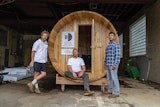
Learning how to swim may not be the only educational activity going on at your local school pool. SeaPerch, an innovative underwater robotics outreach program, trains teachers to teach their students how to build an underwater remotely operated vehicle (ROV) in an in-school or out-of-school setting. A few years ago, the program started small with a mere 750 students, but has now reached over 26,000 students in 30 states.
"The Titanic was discovered by ROVs and the oil spill in the Gulf of Mexico last year was capped by ROVs," says Susan Nelson, executive director of the SeaPerch program. "A huge portion of what people do now underwater is done with ROVs, both manned and unmanned. They're used extensively in the military and for commercial purposes."
At school or in after-school programs, groups of two to four students build the ROV from a kit comprised of low-cost, easily accessible parts, following a curriculum that teaches basic engineering and science concepts with a marine-engineering theme.
Building a SeaPerch ROV also teaches basic skills in ship and submarine design and encourages students to explore naval architecture and marine and ocean engineering concepts.
The Navy's Office of Naval Research, through the National Naval Responsibility for Naval Engineering, supports the SeaPerch program with the goal of finding the next generation of naval architects and marine engineers. The kids like it because they get to build really cool shoebox-sized ships with power tools. It's some serious hands-on learning.
To launch a SeaPerch program, schools and organizations like 4-H and the Boy and Girl Scouts apply for a grant from the program to get them started with kits, materials and sometimes training. "What the school or organization is asked to do, going forward, is to find ways to fund it, whether it's through their school district budget or a sponsor. We don't leave them 100 percent hanging, but we need each group to become self sustaining for us to move on to the next group of kids," says Nelson.
"In Philadelphia, they came across SeaPerch before we even launched the program. They bought the materials listed in the book How To Build an Underwater Robot by Harry Bohm and Vickie Jensen, and have built a very successful model of how to make it self sustaining because they have corporate sponsors and local sponsors and university help," says Nelson. "They've built a successful model in terms of how to partner, which is needed because the government doesn't have unlimited resources to fund this program."
Philadelphia's Drexel University, in fact, just hosted the first-ever National SeaPerch Challenge in May, and previous to that, there were regional competitions. As part of these challenges, students often have to navigate their ROV through an underwater maze to collect objects in a swimming pool.
The SeaPerch program is in need of local and/or national sponsors to keep it going. If you have any interest in becoming involved in any way with this program, contact Nelson at [email protected]. To learn more about the program, go to www.seaperch.org.











































